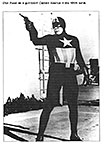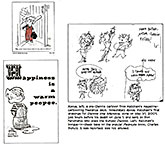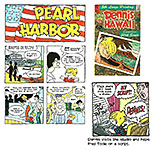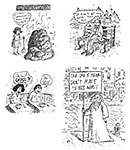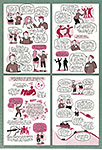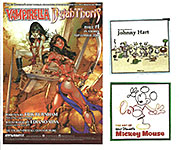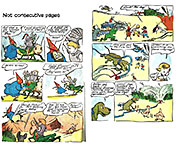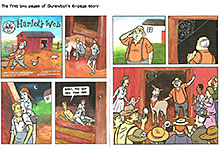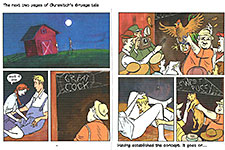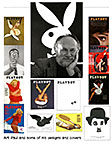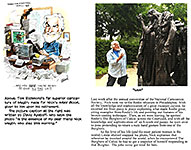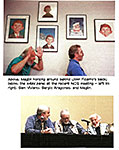 |
||||||||||||
Opus 382 (completed July 31, 2018). Down the rabbit hole this time, we look at conservative editoons arousing reader ire and do book reviews of Hollywood and the Comics, a new Peter Wheat reprint, Assume the Worst: Graduation Speeches You’ll Never Hear (truthful ones), and a graphic instructional tome on sex. We also report on DC Black Label’s morphing into a reprint imprint, and we start a new department devoted to the antics of our wispy-haired Prez, Trumperies (as distinct from politics and national issues). And we have our usual departments on editoons and newspaper comic strips. Oh—and we are both humbled and honored to have received the San Diego Comic Con’s Inkpot Award “for achievement in the comic arts.” We also tell you more about Tom Tanquary’s documentary video on the history and influence of newspaper comic strips in America—which relies upon interviews with 20 well-known cartoonists—and show you how to help make history by joining the Kickstarter campaign to fund the last stages of the film’s production. And we post an extensive and fond farewell to Mad’s Nick Meglin, who died unexpectedly June 2. If you’re a non-$ubscribing visitor here, taking advantage (as we encourage you to) of our Open Access Month, you might consider wandering from the Rants & Raves posting at hand to look at some of the evergreen articles of history and biography in Harv’s Hindsight. Here are a few—: Hubris & Chutzpah, the Al Capp/Ham Fisher Feud that Resulted in Fisher’s Death, posted January 29 2013 (click on Harv’s Hindsight, then scroll down to this date) Origin and Evolution of the “Comic Con,” November 30, 2017 Who Discovered Superman?, November 30, 2013 Hefner Died. In His Bed, Of Course, October 31, 2017 Unforgettable Jane (the British Comic Stripper), September 30, 2016 The Real Captain Easy, January-February, 2012 In the meantime, we provide the following list of this Opus’s content so you can pick what you want to see without having to read through everything. Here’s what’s here, in order, by department—:
MAKE HISTORY Join Our Kickstarter
NOUS R US Old Duffer (RCH) Gets Inkpot at Sandy Eggo Con Stan Lee’s Situation Still Unclear Sales Decline Slightly in 2017 DC Black Label Titles Are Reprints Nemo to Return; Ditto Inks Scholarly v. Academic Discussed Rob Rogers’ Spiked Editoons On Display Conservative Editoons Spark Reader Objection Glenn McCoy Laid Off; Takes Up Animation Wedding Plans Foiled Garfield Is Forty The Toothpaste Caper in Gas Alley Odds & Addenda Watterson Editorial Cartoons Statue of Archie Simpsons Comics Dies Off
The Utterances of Art Spiegelman
FUNNYBOOK FAN FARE Batman White Knight Ends Badly Doomsday Clock Limping Along Shipwreck and Skybourne Too Long in Coming Plastic Man’s Essence Is Still Illusive Renato Freelancer Ends Second Round Well
TRUMPERIES The Guy’s So Silly He Rates a Department Separate from—:
EDITOONERY Rounding Up Highlights of the Month’s Editorial Cartoons
NEWSPAPER COMICS PAGE VIGIL The Forbidden and the Intriguing in Today’s Funnies
ACCRETION OF INTENTION DEPARTMENT Review of Hollywood and the Comics BOOK MARQUEE Short Reviews Of—: Pocket Full of Dennis the Menace Dennis the Menace in Hawaii Assume the Worst: Graduation Speeches You’ll Never Hear Feiffer Triology Concludes with The Ghost Script Instructional Book on Sex
BOOK REVIEW Of The Adventures of Peter Wheat
A-GAGGING WE SHALL GO Playboy Still Isn’t Cutting It
PASSIN’ THROUGH Art Paul Nick Meglin Harlan Ellison
QUOTE OF THE MONTH If Not of A Lifetime “Goddamn it, you’ve got to be kind.”—Kurt Vonnegut
Our Motto: It takes all kinds. Live and let live. Wear glasses if you need ’em. But it’s hard to live by this axiom in the Age of Tea Baggers, so we’ve added another motto:. Seven days without comics makes one weak. (You can’t have too many mottos.)
And our customary reminder: don’t forget to activate the “Bathroom Button” by clicking on the “print friendly version” so you can print off a copy of just this installment for reading later, at your leisure while enthroned. Without further adieu, then, here we go—:
HERE’S A CHANCE TO HELP MAKE HISTORY If you enjoy
our twice-a-month trips down the rabbit hole for comics news and reviews and
history and lore, maybe you would like to help make history. Here’s your
chance. For the past several years, I’ve been working with an Emmy award
winning television documentarian, Tom Tanquary, to make a film about the
American newspaper comic strip and how it influences our culture and vice
versa. I talked with Greg Evans, Cathy Guisewite, Jules Feiffer, Mell Lazarus, Wiley Miller, Brian Walker, Mort Walker, Lalo Alcaraz, Sandra Bell-Lundy, Ray Billingsly, Bill Holbrook, Darren Bell, Jeff Keane, Keith Knight, Morrie Turner plus active observers like Jeannie Schulz, Andrew Farago at the Cartoon Art Museum in San Francisco and historian Peter Maresca (Sunday Press). We visited the Walkers, Ray Billingsly and Jules Feiffer on one harrowing week in the spring. Bad weather forced us to land, briefly, in Philadelphia; then on to New York, where Tom had rented a van. By then, it was night, and we made our way to the Hamptons (where Feiffer was) in the dark. Thank goodness for GPS; otherwise, as in the olden days, we’d still be wandering the countryside. It was lunchtime when we dropped in on Knight, so we all went off to a local fast-food spot. As we ate, Keef drew a Sunday strip—right there, before our very eyes—wholly imperturbable. And as he drew, he answered our questions and responded to our comments. The plan was that I talk to cartoonists. I’d talk to them about the profession, their strips, and the syndication business. And then later, Tom would edit the video, taking out only what he wanted for the documentary. In effect, I was left entirely to my own devices and desires, so I followed myself happily. Among the things that I remember was that Feiffer, who was working on his second graphic novel while we were there, said doing a graphic novel had reinvigorated him. Suddenly—once again—he loved drawing and cartooning again. None of this is apparent in the documentary, but I think you can tell everyone is having a good time. I was anyhow. Tom is now moving into the post-production phase of making the film. So far, he’s financed the whole project himself; but now he needs to hire people with expertise he doesn’t have in order to finish the film, and he’s launched a Kickstarter to raise the funds. Herewith, the News Release—:
Picture and Sound Productions announces the final stage of development for its feature length documentary: “Hand Drawn Life – The History and Influence of Newspaper Comic Strips”
UNLIKE OTHER WORKS ON THIS SUBJECT, “Hand Drawn Life” traces the history of the newspaper comic strip by detailing its effects on the readers and its impact on society. The film explores not just the timeline of their creation but the emotional connections these drawings have had, and are still having, on the reader. These strips are arguably the first form of American pop culture. Unlike the books, sheet music and traveling side shows of the late 19th and early 20th centuries, newspaper comics were syndicated to papers across the country, thanks to William Randolph Hearst. This meant for the first time, people in New York, Los Angeles, Chicago and elsewhere could read the same cartoon at the same time. These cartoons united the country in a common entertainment experience like never before. And they continue to connect readers to this day. With interviews from 20 of the greatest names in the comic strip world, both creators and historians, the story unfolds without a narrator. The people that know best weave history and personal experience into a tale of modern American culture. They explore how these comics, deployed by newspaper editors to sell newspapers, turned into a truly unique art form. Not just their ability to craft a gag or joke in just a few panels of drawn figures, but also to convey complex ideas and emotions, to create other worlds and fantastic stories, and to let millions of readers know they are not alone. They have their trusted friends right there on the comics page, day after day, with new adventures and laughs, new stories to tell. Jeannie Schulz, widow of Charles Schulz, says in the film: “People may read the comics to get away from themselves, but in Peanuts, they found themselves.” That could also be said of comics in general. Even with radio, movies, television, and now the internet, comic strips continue to connect with their readers. This is their story. The Kickstarter campaign to get finishing funds for post-production is underway. To hear Tom explain it (he does a better job than I do) and to see a short preview of the 90-minute film, go here: https://www.kickstarter.com/projects/228655795/hand-drawn-life?ref=email
READ & RELISH “Its better to prepare children than to repair them.”—Jim Zimmerman, former Macy’s chair Upon being named U.S. poet laureate in 2006, Donald Hall explained his simple view on the value of poetry: ‘There is no other purpose than the beauty of it,’ he said, ‘—and that is reason enough to be.’”
NOUS R US Some of All the News That Gives Us Fits
OLD DUFFER GETS INKPOT
Recipients in the inaugural year include legends in movies and popular culture and in the histories of cartooning and comics fandom: Forrest J. Ackerman (magazine editor) Ray Bradbury (prose writer) Kirk Alyn (actor) Milton Caniff (cartoonist, Terry and the Pirates, Steve Canyon) Frank Capra (filmmaker) Bob Clampett (animator) June Foray (voice actress) Eric Hoffman (film historian) Chuck Jones (animator) Jack Kirby (comic books) Stan Lee (comic books) Bill Lund / William R. Lund (actor/writer/founding member of San Diego Comic-Con) Russ Manning (comic strips, Tarzan, Star Wars) Russell Myers (cartoonist, Broom Hilda comic strip) Charles Schulz (Peanuts) Phil Seuling (comic art convention founder) Roy Thomas (comic book writer and fan, co-founder of Alter Ego) Bjo Trimble (science-fiction fandom figure)
I’M IN DISTINGUISHED COMPANY and am appropriately humbled as well as honored. Recipients of the Inkpot Award are chosen by the Con’s board of directors. The Inkpot tradition probably began with a suggestion from Mark Evanier, Mark told me, who thought the Con ought to confer some sort of award. The Con’s founder, Shel Dorf, sometimes claimed to have started it all, but he is more likely the person who named it. “Inpot” is the term a previous generation used to denominate an ink bottle. Shel was doubtless familiar with the old term because of his association with Milton Caniff. Shel lettered Caniff’s Steve Canyon for years, but it was a famous story about Caniff that carried the term into modern times. Caniff worked his way through Ohio State University by drawing in the art department of the Columbus Dispatch, whose fabled editorial cartoonist was Billy Ireland. Caniff did a lot of acting in college and toyed with the idea of becoming an actor instead of a cartoonist. One day, he asked Ireland for his advice, and Ireland famously responded: “Stick to your inkpots, kid—actors don’t eat regularly.” The
Inkpot trophy, designed by cartoonist and graphic novelist Rick Geary,
is, as you can see in the accompanying visual aid, an elegant statuette in
polished ebony, 10 inches tall: a cartoony anthropomorphic ink bottle stands
atop a pedestal, one hand on its hip, the other holding a pen. The bottle
stopper is its hat. The honor came with accouterments. I was invited to the Con as a “special guest”: my airfare and that of a companion (my wife, Linda) was paid, ditto hotel room at the Marriot Marquis (next door to the Convention Center), and we received a daily meal allowance. I was required to make at least one presentation. Mine, on Friday, 4-5pm, was entitled “How Not To Read Comics Like a Book,” a missionary effort intended to draw attention to the visual character of the medium. I was introduced by Gary Sassaman, editor/designer of the Souvenir Program, with whom I had been working on articles for the publication for 10-15 years without having ever met him. So the event was, for me, a double treat. More about this year’s Sandy Eggo Con next time, Opus 383. Serendipitously, a long article about my so-called cartooning career has just been posted at the website of the Chicago Chapter of the National Cartoonists Society. As a member of the Chicago Chapter, I (like other members of the Chapter) was asked a series of questions for the online feature “Drawing Interest,” and, as usual, I went on at great length, producing more answers than there were questions. You can find the piece here—: http://ncs-chicagocartoonists.com/harvey-drawing-interest/ Once there, you can choose other destinations at the site by clicking on the listing across the top (“Home,” “Feature,” etc.).
SWELLS MY HEAD
You can expect to see that on my tombstone. And in various venues that promote this website. I hope you don’t confuse the two.
LEE’S STATUS STILL QUESTIONABLE According to an Associated Press report on July1, Stan Lee’s situation is still cloudy: “It’s unclear who currently surrounds Lee and is managing his affairs.” But it’s clear he needs someone: “Lee has shown severe impairment with his hearing, vision, short-term memory and judgement. ... A series of court hearings for Keya Morgan [who is a virtual caricature of a con man in appearance and who has befriended Lee’s daughter, Joan Celia, ‘J.C.’ through whom he may be influencing Lee] on the false emergency charges, a probation violation on an unrelated case that his arrest triggered, and the restraining order, may bring clarity.” Alas, I’ve seen nothing so far (July 30) on the outcome of this early July court appearance, but a restraining order on Morgan that he must stay at least 100 yards away from Lee and his home has apparently been extended.
SALES DECLINE IN 2017 Calvin Reid at publishersweekly.com reported that combined North American sales of graphic novels and periodical comics declined about 6.5% to $1.015 billion in 2017, according to a joint estimate made by pop culture trade news sites ICv2.com and Comichron. The 2017 sales decline ended a multi-year run of annual sales growth that began about 2011, but Milton Griepp, CEO of ICv2, said despite a soft market in 2017 there were positive signs in sales of the graphic novel format. “The relative strength in the graphic novel and digital markets, especially the growing market for kids’ titles across print channels, bodes well for the future,” Griepp said. For kids’ books maybe, but what about books for all us old duffers?
DC BLACK LABEL TITLES The DC Black Label badge is supposed to be for stand-alone stories that happen outside the current DC Universe, material written and drawn by high profile creators. But most of the first titles are merely reprints. DC Entertainment is calling this maneuver “rebranding,” but that’s just a fancy word for “reprinting,” seems to me. Two of the first three titles are, I think, “previously released material.” DC has already rechristened the upcoming trade paperback for Batman: White Knight by Sean Murphy as a Black Label title, reports ICv2. Set to release on October 3, it will be the first collected edition from the new imprint. A second rebranding is in DC’s August solicits, a new edition of All-Star Superman TP by Grant Morrison and Frank Quitely, originally released in the mid-00s, now freshly reissued as a Black Label title. The first announced new Black Label material, Superman: Year One by Frank Miller andJohn Romita Jr., is due later this year. This one, I think, is new material. Other titles that stand apart from DC continuity may also be repackaged as Black Label books in the future.
NEMO TO RETURN; DITTO INKS Ventures Into Comics Scholarship Fantagraphics is bringing back a distinguished magazine of appreciation of vintage comics arts, Nemo: The Classics Comics Library, which ran for 31 issues, ending January 1992. Rick Marschall, who will return as editor, says he’ll be joined by “a large editorial and creative team, many already on board, [including] John Adcock, who has piloted the splendid online magazine Yesterday's Papers (and will continue); and Jon Barli, my partner at Rosebud Archives and Art Director of a recent Comics Journal monster.” Marschall says the new incarnation will be annual or bi-annual, oversized, printed on quality stock with board covers, substantial color sections and approximately 200-plus pages each issue. A book, in other words. “Nemo’s focus,” he continues, “generally will be what the first incarnation's was: the art of cartoons and the art form of the comic strip; a general hew to the roots of comics; golden age as defined as late 1800s to 1940s and1950s; enthusiastic examinations of cartoons, strips, animation, illustration, political cartoons, graphic satire, poster art and advertising, children's books, licensing and merchandising, and related forms of movies and animated cartoons; running features like Penmen of the Past and Eyewitness to Comics History—plus new features like Monographs and Annotated Portfolios.” To which, he adds, crucially, “Nemo will be— take this as a description and promise, not a mere slogan— Scholarly but not Academic.” Marschall makes a nice distinction—scholarly but not academic. “Scholarly” means researched and factual; “academic” too often means theoretical essays overflowing with high-fallutin’ language about subjects too obscure and esoteric to be of any lasting interest to anyone except the author who publishing his dissertation. A recent issue of Inks, the revived academic journal now published under the auspices of the Comics Studies Society, contains examples of both academic and scholarly enterprises. In the former category are articles entitled “Photography as Narrative, Aesthetic, and Document in Documentary bande dessinee: Emmanuel and Francois Lepage’s La Lune est Blanche”; “New Energy for Indian Comics: A Qualitative Study at Comic Con India”; “‘It was a Dark and Stormy Night...’: Intertextual Metafiction In and About Peanuts”; and “What’s Diagnosis Got To Do with It? : Psychiatry, Comics, and Batman: The Killing Joke.” Intertextual metafiction? Comics in India? “This research,” writes the author, Mara L. Thacker, “brings to comics studies an understanding of the cultural status and circulation of comics in India.” Do we need to know that, here in the U.S. of A.? Well, I suppose. Sometimes I think knowledge factories like colleges and universities need research in such areas in order to justify their existence. But only on otherwise idle Saturday afternoons in August. The rest of the time, I realize that knowledge is knowledge and knowing something is better than not knowing something. Scanning titles like the foregoing convinces me that the writers, likely academics all, are in rather desperate search for a topic that will permit them to write about their favorite subject, comics, in ways that will (a) earn them the Ph.D they’re working for or (b) get them another line on their vitae sheet as a step toward future promotion. The issue of Inks at hand also includes a genuinely valuable scholarly contribution to comics history and our understanding of it—namely, a short factual article about an obscure and short-lived adventure comic strip, Deathless Deer (November 9, 1942 - August 7, 1943), written by the founding publisher of Newsday, Alicia Patterson (daughter of Joseph Patterson, the editor who shaped comic strip history with The Gumps, Dick Tracy, Terry and the Pirates et al) and drawn by the celebrated artist Neysa McMein. The article, deft and succinct, by Jared Gardner, editor of Inks, traces the history of Alicia mostly, a friend and fellow feminist of McMein’s, but it is accompanied by 24 daily installments of the strip (May 10 - June 10, 1943), which we have never seen in more than an occasional single daily or, worse, just a single panel.
In a mere 23 pages, Gardner has enriched our knowledge of comic strip history.
ROGERS ON THE WALL The Corcoran School of the Arts and Design launched a pop-up show of cartoons by Rob Rogers. Conveniently located across from the White House at the Atrium Galleries at Flagg Building, 500 17th Street NW, the Trump-centric exhibit showcases all the cartoons killed by Rogers' former employer, the Pittsburgh Post-Gazette. See Opus 381 for details about Rogers’ firing for drawing cartoons critical of the Trumpet. Co-sponsored by the Association of American Editorial Cartoonists (AAEC), “Spiked: The Unpublished Political Cartoons of Rob Rogers,” runs July 18 to Oct. 14. The Corcoran will be hosting a "series of conversations regarding issues around censorship, freedom of the press, journalistic integrity and the consequences of nationalism to a democracy in collaboration with both the AAEC and George Washington’s School for Media and Public Affairs." Visit
CONSERVATIVE EDITOONS SPARK READER IRE Well, Isn’t That What They’re Supposed To Do? No: Not Really Editoons with a
pronounced conservative representation of the border brouhaha provoked by the
Trumpet’s “zero tolerance” policy have whipped up reader outrage in at least
two newspapers. Elsewhere, the Bucks County Courier Times printed an apology for rabid conservative Gary McCoy’s cartoon at the upper right after angry readers jammed the newspaper’s phone lines. Cartoonist/reporter Rob Tornoe, covering the story, supplied more detail—: “It was a searing criticism and, in retrospect, the cartoon handled both issues without the delicacy that might have helped make the point without alienating readers,” wrote Guy Petroziello, the editorial page editor of the Courier Times, adding that the cartoon drew additional criticism for its “racial overtones.” “I thought the cartoonist, not in a subtle way, raised the issue of hypocrisy, which I thought was a relevant issue,” Petroziello said. “I heard this argument from … folks who are up in arms over the separation of children from their families at the border, yet have little concern about unborn babies separated from their mothers” [i.e., aborted fetuses]. Readers didn’t see it that way, reported Tornoe. Petroziello said the newspaper’s phone lines were flooded after the cartoon was shared on social media, with editors and reporters fielding heated complaints. One reader told Petroziello her daughter was in tears over the cartoon. “I make no apologies for bringing to light the hypocrisy I see from those on the left advocating for the welfare of immigrant children while at the same time accepting the murder of children in the womb,” editoonist McCoy said. “The reason I depicted an African American woman at the Planned Parenthood counter is to point out, again, that the organization aborts a large percentage of black babies.” It might be noted that there are relatively few conservative editoonists; by far the bulk of the editooning breed are liberal. As am I. So I’m delighted to see that readership of these two newspapers was liberal enough to cry out at the exaggerated presentation of a conservative point of view. Oh, by the way—Planned Parenthood does not offer abortion services. Only counseling, recommendations, etc.
STIGLICH GOT IN TROUBLE AGAIN at another newspaper recently with the cartoon at the lower left in our previous visual aid. The cartoon obviously warns against the danger of going to sea (or to lake) in a duck boat, that amphibious craft that can travel on both land and water, by depicting a duck boat as a hearse, the very vehicle of death. But when the cartoon ran in the Dyersburg State Gazette, readers were offended. The paper published the cartoon just a week after the fatal duck boat accident in Branson, Missouri, where 17 people died when the duck boat sank in bad weather. Two of the drowned were citizens of a town within an hour’s drive of Dyersburg, and Dyserburgians were understandably upset by a cartoon (of all things—just a laugh-provoking genre?) about so recent a proximate tragedy. Ire flowed. The paper’s regional editor Shelia Rouse released this statement on the matter–: “While we are upset about the editorial cartoon, we are also losing site [sic] of the way the creator intended to relay a message. The wording, along with the editorial cartoon, was done to bring awareness to the fact that people are dying in these types of tour vehicles. In no way did anyone on our staff mean any disrespect. The editorial cartoon alone is despicable. The message along with the cartoon was meant to bring awareness to a senseless tragedy that could have been prevented and should be changed in the future to prevent further injuries and loss of lives. Look at the message along with the cartoon to have a better understanding of how this was construed by the individual who produced this. We must also remember editorial ‘cartoons’ are not necessarily meant to be humorous. They are meant to be informative and are the opinions of the creator.” I disagree with the “despicable” part: the cartoon was just a strong visual warning about a clear and present danger to duck boat tourists. But otherwise, Rouse’s statement is sound journalism—objective, reasoned, courageous in an age when too many newspaper editors quake at any criticism from readers. A couple days after her statement was published, the paper's general manager, Mike Smith, had more to say on the topic. Smith is more typical of the timorous newspaper factotum of today. He blamed it all on a copy editor (albeit an employee of the paper for 20 years; scarcely a novice making a mistake of inexperience). The employee was being dealt with “internally,” Smith said. And he gutlessly apologized for publishing a cartoon of such “poor taste.” Phooey. Don’t apologize for something you publish or you’ll end up apologizing for the whole fish wrap. Geez. Cartoonist Stiglich in Philadelphia released this statement in response to the backlash: “I drew the duck boat cartoon with the intention of trying to save others from the horrific grief survivors must be enduring. ... In Philadelphia (my hometown), two tourists were killed when a duck boat was hit by a barge in 2010. In 2015, five people were killed and 69 others were injured when a duck boat collided with a bus carrying a group of students in Seattle. Just one year later, there were three separate crashes. One took place in Philadelphia, while two happened in Boston, prompting officials to increase safety regulations. I feel not enough is being done. It's not a fun, humorous topic, and in no way was I trying to make light of this horrible tragedy.” —as anyone with any smarts could tell. Rouse’s muscular, unflinching explanatory statement was more than adequate for the occasion; Smith’s apology was excessive and a betrayal of journalistic integrity. But Rouse’s statement inspired more reader outrage. Geez. Meanwhile, we should remember that in some other countries, editoonists, whether liberal or conservative, endanger their very livelihood (and sometimes lives) by drawing cartoons critical of government or of society or the reigning culture. In Israel, for instance, Jerusalem Post editoonist Avi Katz was recently fired for depicting Netanyahu as a pig in homage to Orwell’s Animal Farm, mocking a celebration of the nation-state law (which some see as racist). Here in the U.S., until the despicable treatment of Rob Rogers (again, see Opus 381), editoonists usually survive the ire of elected officials and unelected readers who are offended.
THE OTHER McCOY Gary McCoy’s brother Glenn, also an angry conservative editoonist, has been laid off at the Belleview, Illinois News- Democrat after 22 years. Not, alas, because the paper wanted to silence his rank conservative voice. Nope: the paper simply could no longer afford the luxury of a staff editoonist. As the editorial board put it in announcing McCoy’s departure: “The News-Democrat was always an anomaly by being a mid-sized daily newspaper with its own staff editorial cartoonist, and we held on to that tradition at the peril of other coverage for as long as we could. But we must be conservative with our resources until digital subscribers foster new growth. We remain a thriving business, and these economic decisions are intended to ensure we protect the local journalism at the heart of our business. “While we no longer will have Glenn's editorial cartoons to publish, we still carry two of his creations,” the announcement continued: “The Duplex [comic strip] and The Flying McCoys [panel cartoon], both drawn in collaboration with his brother Gary McCoy, will continue as part of our daily print and online offerings. “No doubt we're sad that this day came. We were lucky to have a Belleville boy with so much talent share it with us for so long. So we say, ‘Thanks, Glenn.’ Best wishes for a safe flight to an amazing destination.” But Glenn isn’t at all broken up by losing his desk at the News-Democrat. Glenn is not only leaving the News-Democrat: he is putting away his editooning pen. Glenn has been successfully pursuing a career in animation, most notably his work with the "Despicable Me" series and the minions. That part of his career is taking more of his time and concentration. And he’ll continue in that direction.
WEDDING WHOOPS The much-anticipated wedding of Batman and Catwoman, Bruce Wayne and Selina Kyle, didn’t take place. Selina spends the big day pondering whether or not marrying Wayne is the right thing to do, and she decides it isn’t: she decides that wedded bliss would spell the end of Batman, and keeping Batman going for the good he does for Gotham City is more important than either of them happy-ever-aftering, so she leaves Wayne standing at the altar. This unhappy ending is revealed in Batman No.50, but the New York Times provoked the anger of Batman fans by revealing the outcome days before No.50 hit the stands. DC Comics had approached the Times comics reporter, George Gene Gustines, about covering the wedding in the newspaper’s wedding section. In a special report on fan reaction, the Times said Gustines happily went along with the idea, covering the story as if it were a news event in which aborting the wedding was the news—thereby spoiling the suspense by revealing the outcome. Fans were outraged. Gustines was puzzled: “I reported on the planned wedding of two X-Men, which did not occur, a day before the comic (a terrific issue) came out, and there was no noticeable reaction to that spoiler.” Had there been a reaction, Gustines said, it would have “informed my thinking on the Batman-Catwoman wedding story.” When Robin died in 2013, his death was reported in the paper before it occurred in the comic book. No fuss apparently. But fans didn’t excuse the Times on the Batman-Catwoman wedding: Steven Fino in Philadelphia wrote: “Choosing to give away a major plot point in a comic before anyone even has a chance to read it does an incredible disservice to the characters themselves, the creators behind their stories, and anyone who enjoys reading those stories.” Gustines, chastised, said: “I’ve taken everyone’s reaction to heart I will be incredibly more sensitive to spoilers and timing, and I will work hard to regain the trust and confidence of my fellow comic book fans.”
GARFIELD IS FORTY Uclick’s GoComics team asked Jim Davis some questions on the occasion of Garfield’s 40th birthday (anniversary of the strip’s launch). Herewith—: GoComics: Jon Arbuckle, Garfield’s master, introduces himself in the first strip as a cartoonist, but then never mentions it again. Is Jon still cartooning, or has he moved onto other interests? Jim Davis: In the TV shows and in the movies, there will be an occasional reference to Jon's profession--yes, he's still a cartoonist. But since the strip focuses on Garfield, and Garfield is a rather selfish creature, it seems inconsequential what Jon does for a living. As long as he brings home the bacon. [Incidently, the first years of Garfield are about to be reprinted by Ballantine Books. See Jon at the drawingboard!] GoComics: For people who have followed Garfield for 40 years now, who know the characters almost like family members, what can they look forward to from the strip in the coming years? Jim Davis: I'm of the mind, "if it ain't broke, don't fix it," but I try to keep an open mind about the strip's direction. I'm not planning on doing anything to shock the audience— they count on Garfield to be Garfield, just like they count on Snoopy to sleep on his doghouse, and Charlie Brown to miss that football. I will say this, though: the characters are well-developed enough that they sort of write their own scripts. I just put them in a scene, and then sit back and watch what happens. Of particular interest will be Garfield's relationship with Arlene, and Jon's relationship with Liz. So, if one of them decides to do something radically different, who am I to stop them?
THE TOOTHPASTE CONSPIRACY IN GASOLINE ALLEY A couple of years ago, my anyule letter began with this comedic observation—: IN A YEAR FRAUGHT with faux political turmoil (as well as real turmoil; but we’ll leave that to others to expose), I discovered what is undoubtedly “the latest false alarm.” Another capitalistic conspiracy has slipped in among us, wholly undetected until now. The plot is the devising of the toothpaste and toothbrush cabal. How many of you (raise your hands) use toothpaste? And when you apply it to your toothbrush, do you lay out the ribbon of paste so it completely covers the bristles, fore and aft? Just like in the illustrations in the adverts? Of course you do. Did you know that the toothbrush people have been slowly increasing the length of the row of bristles? Well, they have. In collusion with the toothpaste people, the toothbrush people are thus forcing us to use more toothpaste. The longer the length of the row of bristles, the more toothpaste we’ll use in order to lay out a ribbon of it along the full length of the row of bristles. And so the toothpaste people will sell more toothpaste. Then they divvy up the increased revenue with the toothbrush manufacturers to cover their cost in retooling their toothbrush assembly machinery. Well, I told you it was a conspiracy, didn’t I? And a fine false alarm it is, too.
A FRIEND OF MINE, Jim Scancarelli, who produces Gasoline Alley (now in its 100th year), was one of the recipients of my holiday missive, and the notion of the conspiracy lurked in the back of his mind until a few months ago. He phoned me and asked if he could use the conspiracy in the strip. Delighted, I said, Yes. And so he did, managing to stretch a few of my paragraphs into a two-week continuity. Then Jim suggested I post the whole story here. And so we have, right here at the elbow of your eye.
ODDS & ADDENDA A selection of
editorial cartoons by Bill Watterson, who editooned for Sun Newspapers
in the 1980s before conceiving Calvin and Hobbes, was posted by Tony L.
Smith; google “cleveland editorial cartoons” to find the display. Here are a
couple that show both the cartoonist’s prescience and the ■ A life-size bronze statue of a red-haired, freckled Archie will soon greet visitors to Meredith, New Hampshire, where the character’s creator, Bob Montana, lived for 35 years until he died from a heart attack in 1975 while cross-country skiing. Pictured near here is a mock-up of what the statue will look like.The full-size statue will be commemorated August 9 at Meredith’s community park to coincide with the town’s 250th anniversary. ■ Simpsons Comics, the 25-year-old flagship title of Matt Groening’s Bongo Comics, will end in October with its 245th issue this October.
Fascinating Footnit. Much of the news retailed in the foregoing segment is culled from articles indexed at https://www.facebook.com/comicsresearchbibliography/, and eventually compiled into the Comics Research Bibliography, by Michael Rhode, which covers comic books, comic strips, animation, caricature, cartoons, bandes dessinees and related topics. It also provides links to numerous other sites that delve deeply into cartooning topics. For even more comics news, consult these four other sites: Mark Evanier’s povonline.com, Alan Gardner’s DailyCartoonist.com, Tom Spurgeon’s comicsreporter.com, and Michael Cavna at voices.washingtonpost.com./comic-riffs . For delving into the history of our beloved medium, you can’t go wrong by visiting Allan Holtz’s strippersguide.blogspot.com, where Allan regularly posts rare findings from his forays into the vast reaches of newspaper microfilm files hither and yon.
ART’S UTTERANCES Pulitzer Prize-winning author and graphic artist Art Spiegelman told students and members of the public just how comics, Jews and art align in a post-modernist world at the Kiva in a presentation titled “Comix, Jews ’n Art— Dun’t Esk.” Known for his acclaimed graphic memoir, Maus, which won him a special Pulitzer Prize in 1992, Spiegelman has been unable to stop talking about Maus ever since. And he admits it. “I spent 13 years making Maus, I spent the next 12 talking about Maus to the public so I’m not sure what to do with comics, Jews and art,” he said, introducing his presentation. He said that he never aimed to create such a cultural statement with Maus, but rather to create a comic book long enough so that “it needed a bookmark and wanted to be reread," a platform that didn’t have a strong foothold [among comics] at the time. To connect his style of comics with art and Judaism, Spiegelman said “comics are kind of the Yiddish of art,” as it operates as a vernacular, especially since the most popular comics back in the 1940s were those in the pages of newspapers. Spiegelman went on to say that while he finds himself to be Jewish by culture, he is not Jewish by faith like his father, the protagonist of Maus. “I identify with the Judaism of Marx, both Karl and Groucho,” he said. “Ultimately, I identify most as a cartoonist-American rather than a Jewish-American,” Spiegelman said while going on to show a slide of a stereotypical Jewish caricature. “This doesn’t mean I’m a self-hating Jew. To quote Woody Allen, ‘I’m not a self-hating Jew— I just hate myself.’” The foregoing comments are lifted verbatim from a report by Jarett Theberge, a visual arts reporter, jtheberg@kent.edu.
FUNNYBOOK FAN FARE Four-color Frolics
BATMAN WHITE KNIGHT finished with No.8, and it was a disappointment. Sean Murphy drew the series with his usual panache, but in too many of his pictures, the characters were so small we couldn’t tell who was who. He also wrote this title, but the story he had to tell was so convoluted that it required pages of expository speech balloons in the early issues, and each new balloon-filled page slowed the narrative. The mcguffin is that the Joker has become a good guy, Jack Napier, who wants to unhorse Batman in Gothan City because the Dark Knight destroys so much of the architectural surroundings when bringing bad guys to justice. Batman doesn’t show up much; it’s Jack’s story. Or so it seems. Entwined is a love story between Jack and Harley Quin, who shows up in two manifestations, one of which wears spectacles so we can tell them apart. Towards the end, the spectacled one seems to be killing the other one with a knife. A happy ending concludes the Jack Napier story: he and Harley get married in the jail to which Commissioner Jim Gordon has sent the on-again off-again villain. (Jack keeps switching back to the Joker, a maneuver seemingly beyond his control. And as he says “I do” to Harley, he’s coughing blood. What’s that about?) Meanwhile, Alfred dies and leaves a note telling Bruce Wayne to look under the loose floorboard in his quarters for something that “you’re ready to see.” Batman never looks. At the end, Batman has been persuaded that Napier is right: the Dark Knight is deeply flawed, and he seeks to make things right by giving the police department all of his advanced technological equipment —“I should have shared my technology long ago. It might have saved a lot of lives”—and by revealing himself, taking off his mask. All of this sounds too much like a wholesale revision of the Batman mythos to be a mere 8-issue series. But a few weeks after Batman White Knight concluded, we have the Batman-Catwoman wedding, an event wholly within the traditional Batman mythos but quite outside the “new” situation as defined by Murphy’s tale. (And then, they didn’t get married at all, leaving Murphy’s setup to stand?) I love Murphy’s drawings. I love his page layouts and panel compositions. He is a master of the medium’s storytelling capabilities and therefore a pleasure to watch. But too much of this tale takes place in pictures too small, and the tale itself, while a novel interpretation of the Joker, is too complex. Alas. Then there’s that loose floorboard and the Joker coughing blood.
ANOTHER DC COMICS undertaking, Doomsday Clock, a sequel to the highly regarded Watchmen by Alan Moore and Dave Gibbons is on shaky ground, too. While Gibbons’ art is clear, the story, attempting to tie subsequent events to the characters Moore and Gibbons made famous, is convoluted and doesn’t make much sense. Yet. It might still, but at No.5 (of 12), we’re far enough along that if the enterprise is to end well, we’d have some indication. But nada. Other
disappointments this month include Warren Ellis and Phil Hester’s Shipwreck, which began gloriously with Hester’s artwork. It ends with No.6, still
gloriously drawn, but that issue has been so long in coming that the narrative
momentum building through the first five issues has been dissipated, destroying
whatever thematic unity it initially contemplated. The same we must say goes
for Frank Cho’s Skybourne, which also took too long getting to
the final, fifth issue. One of the last issue’s scenes offers a particularly
gruesome ending for the bad guy. In
the current reincarnation of Jack Cole’s Plastic Man, now up to the
second of a 6-issue mini-series, writer Gail Simone makes the same
mistake so many of her predecessors at rejuvenating the character made: she
assumes that the creation’s historic wackiness derives from its hero, but it
doesn’t. There are lots of wacky characters in Cole’s Plastic Man —and
lots of wacky situations—but the protagonist is entirely serious and takes his
crime-fighting job seriously. Kaare
Kyle Andrews finished his second mini-series of his Renato Jones:
Freelancer with No.5, and it does not disappoint. The pictures and his
narrative manner are exuberantly unconventional, and it’s a treat to see the
comic book form exploited as insanely as Andrews does.
Forthcoming Dept. I’m having difficulty keeping up. In the latest Previews (No.358), I see that Wolverine is returning. Again. Does he ever stop returning? Where’s he been anyhow? And now Marvel is capitalizing on the success of the “Guardians of the Galaxy” with the comic book Asgardians of the Galaxy; looks like an all girl squad—rampant feminism? Next, #MeToo-ism. And apparently the faux Batman nuptials have rekindled romance elsewhere: on the cover of Iron Man No.4, our hero is kissing Janet Van Dyne. Where’ll that go? And who’s the broad Deadpool is snuggling up to on the cover of No.4? Lady Deadpool? I just can’t keep up. In the same Marvel supplement to Previews No.358, we have the Amazing Spider-Man No.23 followed by Nos.5 and 6. Not the way I was taught to count, kimo sabe. But it’s a growing trend: here’s Venom No.6 followed by No.2. Well, shoot.
READ & RELISH: PART TWO A couple weeks ago, I made an expedition which, among other things, demonstrated why people go to bookstores, particularly second-hand bookstores. Such forays are essentially fishing trips. Fishing is different from hunting. For fishing, you have a fishing pole; for hunting, you have a rifle (or bow and arrow, I suppose). When hunting, you know what you’re going for, and when you see your prey, you get it in the sights of your weapon and fire. But when fishing, you don’t know, quite, what will nibble the hook you drop into the water. Sometimes, you catch something good; sometimes, not so good. Visits to second-hand bookstores are fishing trips. Sometimes, you find some treasure that you’ve always been looking for — or something you didn’t even know existed but a treasure nonetheless; sometimes, you don’t catch anything. —Thanques to the Great Robert F. Hogan for the metaphor
TRUMPERIES HOW IS THE TRUMPET DANGEROUS? you ask. Because our government is being run as if his delusions were true. Let’s take an example—North Korea and the nuclear threat. The Trumpet acts on the basis of his delusions about the world and himself. He doesn’t see that the delusions are a result of his insecurities, which, to compensate for—to over-compensate for— he has inflated his ego to gigantic size. In the grip of his delusion, he believes that he is right and that no one else is. He also believes that the vagaries of his agreement with Kim Jong Un about de-nuclearization are actual achievements. To the extent that they call for Kim to act, some are supposedly “underway”—despite recent information from various intelligence agencies watching North Korea that Kim is actually beefing up his nuclear enterprise, adding a secondary effort to obscure any evidence of his nuclear arsenal while at the same time working on new ICBMs. But the Trumpet is behaving as if Kim were doing everything the Trumpet expects him to. And he isn’t doing everything. Thus, our policy on North Korea is, for the moment, built on a delusion. And the longer we let Kim get away with it, the more danger he represents. All because the Trumpet is deluded.
WITH THIS
PREAMBLE, we’re going to separate editoons about the Trumpet as a personality,
dangerously and bumptiously flawed as he is, from cartoons about issues. But
before we get to drawings designed as editoons, there are other appearances of
the Trumpet, actual photographs and magazine covers, that qualify as cartoons
for this department, and we’ll take a look at some of them. One of the most celebrated is the iconic photo of Spanky, seated, surrounded by world leaders at G7, who are standing, Germany’s Angela Merkel apparently lecturing him and he, seemingly, defying her with crossed arms and a smirk. He looks, as some observers have said, like a 72-year-old toddler having a hissy fit. Nancy Hertzel manufactured suitable dialog for the photograph—: Merkel: Donald, I need you to listen, can you do that? Trump: Uh-huh. Merkel: This is really important, okay? Trump: Mmmm-huh. Merkel: I need you to be honest with me, okay? Trump nods. Merkel: Donald—look at me. Now, did you swallow the quarter or is it still in your mouth? On “CBS This Morning,” Eurasia Group president Ian Bremmer supplied the actual facts behind the photo. Merkel and Canadian prime minister Justin Trudeau had gathered other world leaders to convince Trump to sign an agreement for a “rules-based international order.” The Trumpet, who never wanted to attend the G7 to begin with, eventually signed the document (and then un-signed it while on Air Force One on the way back home). After signing it, he stood up, reached into his suit pocket and took out two Starburst candies, threw them on the table and said to Merkel: “Here, Angela—don’t say I never gave you anything.” More the behavior of that 72-year-old infant than of the erstwhile leader of the free world. Incidently, one body language interpretation of the crossed-arms posture Trump so often assumes is that it is a “tell” revealing that the person is insecure: crossing arms is a defensive maneuver, protecting the person who crosses them, keeping him safe behind this barrier. In our visual aid, we’ve added a couple of “edited” versions of the photograph. The first, at the upper right, is a cartoon re-interpretation (alas, by an unknown cartooner) in which Spanky is portrayed as a monkey in a cage with Merkel offering him a banana. The other is better. In the photo-shopped alteration sponsored by the “Committee to Make American Sane Again” (www.millerwashington.com), the Trumpet is seated at a child’s highchair table, and he has been playing with his food, turning a dish over on his head, his defiant posture suggesting that he’s just said, “There. What do you want to do about it.” On
the next photo-cartoon array, we’ve posted other photos of the Trumpet at
G7—Spanky mugging and mouthing. Other illustrations on the same display show that the Trumpet has not escaped attention on the covers of a couple magazines, which, as is their wont lately, make him the butt of the joke and the cause of national hilarity. Barry Blitt’s cover for the July 30 issue of The New Yorker is entitled “Thumbs Up,” an ironic caption considering the disaster being depicted. The image, Blitt admits, recalls Trump’s majestic descent on an escalator at New York’s Trump Tower to announce his candidacy for the presidency. He didn’t slip and fall then, but he has recently during his visit to the European Union and in his summit with Putin. Asked if the escalator image is always in his back pocket, Blitt said: “Half of this gig—drawing topical cartoon [covers]—is about saving some absurd or iconic moment and then bringing it up at an unexpected or odd time. You can expect that soccer ball that Putin gave Trump to appear in an image in a year or two, probably.” At The Week for July 27, cover artist Howard McWilliam uses the Russian nesting doll as a telling image: inside the Trumpet, is Putin. Our
next non-cartoon cartoon about Spanky the Trumpet is captioned with
explanation. And
with that, we’ll move on to some actual editoons about the antics of the
Trumpet. This batch starts with Mike Keefe’s “Lyin’ King,” in which the
Trumpet is transmorgrified into a lion in order to turn the movie into a pun. Tom Toles offers another take on the Trumpet’s lying with a vivid image: the Prez’s famous jagged signature is inspired by the graph of a lie detector—which Spanky is taking and undoubtedly failing. Makes sense to me. Walt Handelsman moves on to the Trumpet’s obsession with the inadequacy of our intelligence agencies: if he admitted their accuracy, he would have to acknowledge that his election was tainted, thereby belittling his presidency. But as Handelsman shows, that’s already happened: Spanky can’t fill the chair of his office so shrunken is his moral and intellectual stature. Finally, we have Toles’ caricature of Rudy Giuliani uttering yet another of his outlandish legal opinions. The caricature is wonderfully accurate, and, considering that Toles seldom attempts caricature at all, it is all the more marvelous. Now, on to real issues rather than simply Spanky’s laughable eccentricities.
EDITOONERY The Mock in Democracy THE MOST RECENT
of the Trumpet’s dubious achievements is his diplomacy on his visit to the
European Union and with Putin in Helsinki. Next
around the clock, Kevin Siers has a novel visual metaphor showing Putin
controlling the Trumpet. Trump shows up as a Putin puppet often in editoons,
but Siers has revitalized an icon of ventriloquism, Senor Wences, who put
lipstick on his thumb and clenched his fingers to suggest a mouth and then made
his fist do the talking. Spanky’s
stop in England to deride the British prime minister was heralded by a mobs of
Brits roaring their disapproval of him. Among the symbols of their opinion was
a gigantic balloon inflated, we suppose, with hot air, thereby accurately
representing the Prez as a gas bag. Jack Ohman ridicules the Trumpet’s everlasting good opinion of himself. He is so blinded by his egotism that he thinks the British love him. According to Ohman, Spanky arrives at this conclusion solely by looking at himself. The
Helsinki adventure is our next topic, and the opening cartoon by Trevor
Irvin offers a blunt image of how the episode went. Pat Bagley’s image references another current event, the brouhaha Trump raised about NFL football players “taking a knee” during the national anthem as a way of protesting the treatment of African Americans. In Bagley’s cartoon, the Trumpet (with his characteristic long red tie) is not taking a knee in the NFL sense: rather, he is simply kneeling to Putin—assuming a subservient position. Back home in the U.S. of A., the Trumpet found that his groveling to Putin performance during the post-summit press conference had outraged most Americans, including members of his own party. So he “walked back” from what had been his obvious opinion during the press conference to another position of his own fabrication in which he appears less treasonous. Bob Gorrell’s grotesquely comic depiction of a Trumpet walk-back shows vividly how awkward and preposterous Trumpet’s post-summit behavior has been. The summit with Putin revealed what we’ve always known. Blowhards and bullies are cowards. Spanky the Trumpet could not stand up to Putin and say anything even vaguely confrontational to him. That’s because he was afraid. Bullies are usually like that: when brought face-to-face with someone they’ve been blaspheming and castigating from a distance, they can’t do it in person. And the Trumpet wasn’t even speaking critically of Putin. He’s been all compliments unless coached by this staff (to whom he seldom listens). Very personal. That’s why we and all other civilized countries have developed the language and posturing of diplomacy: diplomacy doesn’t rely upon the personalities, however flawed, of the participants. Back home safe in the U.S., the Trumpet fearlessly disavowed his treasonous remarks that gave aid and comfort to an enemy. He has great respect for his intelligence agencies, he said. Sure: he can say that now, with Putin half a planet away. No danger of looking him in the eye when bloviating from the distance of the White House. So, why not? Back your intelligence agencies and agree that Russia meddled in the 2016 election. Putin’s a long way away and can’t hurt you by looking at you sternly. Makes you want to throw up, doesn’t it?
THE TRUMPET’S
trade war adventure is the next subject. Nate Beeler’s metaphor is just as telling: the last ball in the line-up—the American consumer— will experience a terrific whack once Trump’s tariffs set the other economic balls in motion. Handelsman is back on another subject. His depiction of Trump’s office cluttered with the debris of his various ill-considered endeavors while the Trumpet complains that no one is noticing (and applauding) the increase in jobs is a telling image: in the midst of the clutter, who can see job numbers? Or anything else but the clutter? The
impending approval of Brett Kavanaugh’s appointment to the Supreme Court
has riled fewer editoonists than just about any tiny thing the Trumpet does. Phil Hands offers a visual metaphor that simply dramatizes the dilemma inherent in Kavanaugh’s nomination: his confirmation will upset the 4/4 balance of the interim Court. But that balance is, of course, a fiction that exists only so long as there are only eight justices. And that’s never the permanent situation. There’ll always be an imbalance ideologically with nine justices. Those who are alarmed about destroying the fictional balance are therefore delusional. The retiring Justice Arthur Kennedy became something of a darling of liberals because he supported Roe v. Wade and gay rights. And affirmative action and freedom from the state establishment of religion. But he also voted in favor of Citizens United, a despised decision among liberals because it nullifies campaign finance restrictions on corporations, and he seemed to support industrialization over environmental preservation. He cast a crucial vote to gut the Voting Rights Act, to strike down portions of the Affordable Care Act, and to uphold the Muslim ban and state voter purges And his vote effectively elected GeeDubya. This term, he voted with the conservatives in all 14 of the 5/4 decisions. In short, Kennedy, despite a couple of left-leaning decisions, was (and is) a conservative. By some measures, he was the most conservative justice since 1937. The confirmation of Kavanaugh then will replace a conservative with a conservative. What’s all the fuss about? When Kennedy was appointed, it was assumed that he’d be a down-the-line conservative. Turns out he had a conscience that overrode ideology sometimes. Unexpected. Maybe that’ll happen with Kavanaugh, too. It’s happened before with justices on the Supreme Court. In the hopeful meantime, I worry more about Kavanaugh’s affection for the Second Amendment. Judging from previous decisions, he thinks Americans can keep most guns—including even the AR-15 rifles used in some of the deadliest mass murders. Naturally, Kavanaugh has the support of the National Rambo Association (NRA) as well as the Gun Owners of America. That, for me, is the kiss of death for his candidacy for the Supreme Court. At the lower right of our visual display, Bill Day rejoices at the resignation of Scott Pruitt, whose brief tenure at EPA was distinguished by rolling back many regulations that protected the environment and the planet. Next, Mike Keefe points out the absurdity of the recent Supreme Court decision on the right of a Denver baker to refuse to make a cake for the wedding of a gay couple. The ruling is extremely narrow and cannot be applied to other similar situations, but it’s still an absurdity to me. The Constitution’s clear message is that individuals should not be coerced into religious beliefs and/or practices by government. For the government to allow a businessman doing business in the public square to pick and choose his customers on the basis of his religious belief clearly violates that principle. The baker is trying to coerce his customers in accordance with his religious beliefs. And Keefe’s cartoon delightfully, perversely, uncovers the illogic of that action by taking it to an extreme—which the Supreme Court decision seems to allow. But it doesn’t. As I said, the decision is based upon the narrowest interpretation of the facts of the case and rests entirely upon the conduct of a Colorado commission not upon the rights of a businessman to operate a sectarian business religiously. So gay rights have not been trampled as so many commentators on the case seem to think. A
miscellaney finishes today’s sermon. At the upper left, David Fitzsimmons manages
a vivid image for the “summit’ between Kim and the Trumpet. Trump says he’s
“honored” as he shakes Kim’s bloody hand while standing knee-deep in a river of
blood in which human skulls are drifting by. When Alexandria Ocasio-Cortez in New York defeated a 10-term incumbent in the Democrat primary, calling herself a “democratic socialist,” she revived an old Grandstanding Obstructionist Pachyderm shibboleth—“socialism” as a term that strikes terror in the hearts of American voters everywhere. Joel Pett addresses this topic, conjuring up a classroom image to offer a lesson in the political lexicon, revealing the typical GOP fake re-interpretation of an ordinary term for the purpose of frightening us all. Socialism may be the next thing. Writing in The Week, Theunis Bates says: “Left-wing groups like the Democratic Socialists of America have sen their membership surge in recent years, with more and more young adults saying they want free college education and medical care, subsidized housing and child care.” And they’re so fed up with the invertebrates in Washington, they’re looking for a better way. Bernie Sanders looked good to them in 2016. Socialism may be it—or, at least, a variety of socialism. It may, in fact, be the future of the Democrat Party. Even the chair of the Democratic National Committee, Tom Perez, thinks so. Below Pett, Adam Zyglis brings back an image of inhumane torture to announce the confirmation of Gina Haspel to lead the CIA, reminding us all that she was involved in arranging black sites for torture of Iraqiis in the good old days of the American invasion of Iraq. And finally, Fitz returns, deploying an image referencing the Thai rescue to chastise the Trumpet for his administration’s separating children from their immigrant parents at our country’s southern border. Trump is wearing a coat that echoes his wife’s attire when visiting those parentless children. Yes, he really doesn’t care. Last night, Steven Colbert told us that parents are being charged $8/minute for phone calls to their children; and some of them are told they must wait 4-5 days to make a call. John Hightower reports on “a little bit of Trumpian evil”—: “Johan, a 1-year-old Honduran boy taken from his amnesty-seeking father by our president’s border agents, was hauled alone into federal immigration court in July to argue for sanctuary. A one-year-old!? An AP reporter wrote that the baby briefly payed with a ball, drank from a bottle, then ‘cried hysterically.’ The judge said he was too ‘embarrassed’ to try explaining this judicial proceeding to anyone: ‘I don’t know who you would explain it to, unless you think that a 1-year-old could learn immigration law,’ the judge said in exasperation. “As it stands now,” Hightower concludes, “insanity reigns, and the inmates are now officially in charge of the national asylum.” The entire episode of dismembering families in the name of border security is a disgrace, now America’s international shame thanks to the Trumpet. That, surely, is enough. But then we had Spanky’s behavior at the Helsinki press conference with Putin.
Clearly, the guy doesn’t know what he’s doing until after he does it and people around him express outrage anew at whatever he’s done. Geez. But before we go, here’s a sketch for an editorial cartoon by my 93-year-old friend and one-time editoonist Jim Ivey. Now retired in Florida in a place where he can enjoy a good cigar on the back porch occasionally, he sent me this, which he conjured up between cigars.It’s the jingle that makes the ’toon. (Or is it “tune”? Sorry.)
TWITTER LITTER Quoted in Previews Phil Hester: Going to start a news network called “Uh-Oh.” Jonathan Hickman: In the past year or so, I’ve written three pilots and two screenplays, and I have no idea if an audience will ever see them. Say what you want about the comic industry, at least most of a creator’s potential energy gets converted into something tangible. Joshua Yehl: By age 35, you should have bought way more comics than you could ever hope to read yet still go into the shop every Wednesday to get more. Sigh. Right you are. Sadly.
NEWSPAPER COMICS PAGE VIGIL The Bump and Grind of Daily Stripping ON THE MORNING
OF MAY 25, I opened the paper to the comics section and had a shock. There,
where I usually browsed Mike Peters’ Mother Goose and Grimm, was
Blondie and Dagwood. And Beetle! Then I took a moment to actually read the
words, and I understood. Peters was celebrating the NCS Reubens Weekend, which
was taking place in Philly even as this strip was published. Ditto the next
two, Friday and Saturday. Peters was just havin’ fun and raising the visibility of the nearly invisible National Cartoonists Society at the same time. When the NCS meeting ended, so did the series in the strip. Nice. In the Sunday Sally Forth below the Peters’ strips, we have a lesson in how not to do a comic strip. Francesco Marciuliano has handily overwhelmed Jim Keefe’s pictures by jamming the entire Webster’s unabridged into the speech balloons. In the fifth panel, there’s barely room enough for Keefe to cram a head into it. Too bad. The joke is in the speech balloons; the pictures contribute nothing except the identity of the speaker. Marciuliano should be writting for radio where pictures have no role at all.
MORE UNHOLY
shenanigans, breaking precedent with body function jokes. In Non Sequitur, Wiley Miller’s joke requires that we see a human posterior in the butte formation in the distance. Despite the continual deluge of potty humor these days, we haven’t actually see what passes for human buttocks in a strip before that I can remember. Another first for Miller. Although maybe not: see Sherman’s Lagoon below. In Pearls, Stephan Pastis poses a question via Rat that I’d not thought of. But it may be the first time the bird has been described in a comic strip. Back to Miller’s Non Sequitur, the characters are discussing the odor of a freshly emitted fart, we gather, by Lucy the donkey in bed with the girl. Probably more about breaking wind—in sheer amount of strip time—than we’ve ever seen. And the sequence carries on for the next couple days. Finally, another posterior visual gag in J.P. Toomey’s Sherman’s Lagoon. And this strip is dated a month before Miller’s butt joke, so maybe Toomey did the first one. Naw: it’s not a human posterior here. But surely someone else at some earlier time has been bringing up the rear.
IT’S FUN TO
WATCH cartoonists play with their medium. They don’t do it often, but they do
it more frequently these days than they ever did in yesteryear, when they
pretended their comic strips existed in a universe all their own, a reality the
fourth wall of which could never be breached or even acknowledged. Then McDonnell turns Mutts on its side to create a vertical dimension that underscores the height of the branch Mooch is dangling from. Our last visual aid doesn’t refer to its form. I’m sticking it here to applaud the artistry of Rick Burchett, who now draws Tom Batiuk’s Funky Winkerbean. I’ve lost track of the continuity—and who the characters are—long ago, but Burchett keeps me watching the strip regardless of my own ignorance about its characters and stories. In this instance, Burchett varies camera angle from panel to panel, ending with a close-up that emphasizes the punchline. He also uses gray tone to shadow as well as “color” his pictures. More so in some strips than in this one.
HERE’S FOURTH OF JULY, the only holiday that goes by its place on the calendar rather than its official name, as Jef Mallett reminds us on the second of our next batch of visual aids. (“Independence Day” anyone?)
On the funnies page of the nation’s newspapers, the holiday is not as thoroughly celebrated today as in the distant past. Almost all comic strips in yesteryear did what Jim Scancarelli does in Gasoline Alley at the top of our first exhibit—line up the cast and have them all yell “Happy July 4.” Dick Tracy does it that way this year, too. And probably others that I didn’t see. In Lio and in Heart of the City, Mark Tatulli takes a somewhat more jaundice look at the festivities. (Yes, Tatulli produces both strips.) Bill Hinds celebrates with a more conventional present-day situation. On the next display, in Mutts, Patrick McDonnell goes patriotic with simple, dramatic symbolism. Clean, unencumbered. Nice. Since I don’t know what the 702nd word in the dictionary is, I can only guess that Jef Mallett means “no” in Frazz. He also does a nice job with the sparklers, trails of smoke and bright lights. Jimmy Johnson turns about in Arlo and Janis, going from cynical to celebratory. And in Over the Hedge, Michael Fry and T Lewis go the other way—from seeming trivial to an allusion about the plight of immigrants on our southern border. Darrin Bell continues in that mode in Candorville, reminding us (a) that the world’s greatest super power has hordes of homeless among us and (b) that to the less fortunate, like the slaves Frederick Douglass references, an “independence day” celebration doesn’t mean much. And then, just for a break, we have Sally in Charles Schulz’s Peanuts attacking a school. We’ve never been far away from the meaningful absurd. Editorial cartoonists celebrate the holiday in a somewhat different way, as we see next with Jim Morin and Mike Luckovich. So it’s a relief to get back to tradition in Brian Basset’s Red and Rover. Happy holiday.
TICS & TROPES T-Shirt Wisdom Eschew Obfuscation It’s so damn cold outside I just farted snowflakes. Stress is caused by giving a crap.
WEATHERVANE ON COLORADO’S MIDTERM INCLINATIONS For anyone eager to know whether Colorado will vote Democrat or Republicon in November, there’s a hint. The Associated Press reports that the Colorado capitol’s wall of presidential portraits is missing one—the Trumpet’s. Presidential portraits cost about $10,000 and are paid for through donations. A local tv station learned that the group that collects private donations for the portraits hasn’t received a single dollar for Trump’s picture. Not a dollar. He apparently does not inspire Republicons. And without his inspiration, I suspect Democrats will out-do GOP at the polls. But Trump’s blank space on the wall didn’t remain blank: a prankster placed a portrait of Putin on an easel below the space where Trump’s portrait would go.
ACCRETION OF INTENTION DEPARTMENT Books In Need of Good Reviews THE RANCID RAVES Book Grotto is littered, literally, with books we acquired with the intention of reviewing them. Alas, they’ve piled up over the years, and it has become increasingly apparent that we’ll never give most of them the kind of intensive examination they deserve. So rather than let the accretion be entirely in vain, we’ve started this new department wherein we’ll briefly (it sez here) describe books by way of urging them upon you, beginning, this time at length, with—:
Hollywood and the Comics By David Hofstede 200 8.5x11-inch pages, b/w photos and text; 1991 Zanne-3 paperback, $12.95 NOT A COMPLETE, ENCYCLOPEDIC history of the movies and serials that have been made from comic book and comic strip characters, but in an age when funnybook superheroes have taken Hollywood by storm, it might be helpful to have this somewhat general rather than detailed treatise on your shelf as a sort of overview. The content spans several decades, from a “Captain Marvel” serial in 1941 to “Superman IV” in 1987. But not everything that was produced in this time span is present in this tome. And the parameter leaves out not a few notable efforts. The 1979 “Buck Rogers” is present but not the Buster Crabbe 1939 version. And the newspaper strip Tailspin Tommy was filmed in 1934 but it’s not here. Buster Crabbe’s Flash Gordon serials (1934, 1936, 1938 and 1940) are covered, but only briefly, just the barest data. This cavalier treatment despite the undeniable popularity of the series: “So enduring was the popularity of these stories,” says Hofstede, “that each one was re-edited into a successful feature film.” The Dick Tracy serials are similarly shortchanged, but Warren Beatty’s 1990 “Dick Tracy” gets the full treatment—which includes, in addition to basic data (date of release, credits for writing and directing and the like, plus a list of actors and the parts they play ) a description of the storyline and a “rating,” or evaluation of the merit of the work. Every entry is also illustrated with at least one photo. The 1978 “Dr. Strange” shows up, as does Robin Williams’ in “Popeye” in 1980. And “Prince Valiant” from 1954 made the cut with a youthful Robert Wagner with bangs in the title role. All four Christoper Reeve Superman movies are covered, and Batman flicks from 1943 on, including the famed 1966 Adam West productions and the 1989 Michael Keaton/Jack Nicholson effort. Lynda Carter’s tv Wonder Woman is here; ditto the Cathy Lee Crosby interpretation of the character for a 1974 movie. Captain America is present in three versions, 1964 and 1979, but it’s the 1944 version that attracted my attention. I saw a half-dozen of this serial’s chapters when living with my grandparents in Kenmare, North Dakota in the mid-1940s. I always wanted to know how it came out, and I finally found a DVD of the thing. No, I haven’t watched it yet: I’m saving it.
This Captain gets around on a motorcycle and carries a sidearm. And, says Hofstede, it’s a “thoroughly entertaining romp from start to finish. ... [D.A.] Gardner makes a spirited Captain America. The almost non-stop fight scenes are reminiscent of Douglas Fairbanks in their acrobatic energy. The hand-to-hand combat is among the best in the serials.” He gives it a high rating, 3 ½ stars out of possible 4. Right. For me, that makes the book worth it.
CLIPS & QUIPS Money can’t buy happiness; but poverty can’t buy anything. I like sleeping because it’s like being dead but without the commitment. If sex between 3 people is a threesome and sex between 2 people is a twosome, now I understand why people call you handsome. I’m sorry I hurt your feelings when I called you stupid. I really thought you already knew.
BOOK MARQUEE Short Reviews and Proclamations of Coming Attractions This department works like a visit to the bookstore. When you browse in a bookstore, you don’t critique books. You don’t even read books: you pick up one, riffle its pages, and stop here and there to look at whatever has momentarily attracted your eye. You may read the first page or glance through the table of contents. And that’s about what you’ll see here, beginning with—:
Pocket Full of Dennis the Menace By Mark Arnold 700 6x9-inch pages, b/w; 2017 BearManor Media paperback, $34.95 HANK KETCHAM’S
panel cartoon Dennis the Menace quickly expanded into a Sunday comic
strip, then a live-action television series (1959-1963), a 1986 animated
television series, and many subsequent books and merchandising enterprises, and
in this fat little book (as thick as it is wide), comic
Hank Ketcham’s Dennis the Menace in Hawaii By Fred Toole (writer) and Al Wiseman (art); edited by Bill Alger, who did all the interviews; Introduction by Mark Arnold 192 7x10-inch pages, color; 2017 Papercutz hardcover, $24.99 THE COMIC BOOK ADVENTURES of Dennis and his family in Hawaii are completely reprinted, including puzzles and maps from 100-page special “giant” comic book and illustrated instructions about how to hula, a map and history of the Japanese attack on Pearl Harbor, plus photos and a “portfolio” of miscellaneous Wiseman sketches, several articles on cartooning matters, a “never-seen-before” interview with Ketcham, and interviews with the artist and writer and others who were involved— one way or another: Ketcham sent Toole and Wiseman and their wives to Hawaii to do “research” for the comic book, and Alger talked to both wives. Arnold speculates that the Hawaii book was “the first to take readers to places they might not otherwise see.” Published in the summer of 1958 before Hawaii was a state, it went through eight subsequent printings. On the cover of the 5th printing in the summer of 1962, Hawaii is congratulated as the 50th state. Arnold estimates that the printings totaled 4.5 million, “making it one of the most successful comic books ever published” and qualifying it for the third spot on a list of the ten best selling comic books of the modern period.
Ketcham said many people took the Dennis books on Hawaii and the subsequent special giants on Mexico, Washington, D.C., London and Paris with them on their travels as guidebooks. “People would write to me and thank me,” Ketcham said. “That was quite something. That was a very flattering result of the whole thing.” We’ll finish with a couple pictures from the book.
Assume the Worst: the Graduation Speech You’ll Never Hear By Carl Hiaasen; Illustrated by Roz Chast 50 5x7-inch pages, b/w and text; 2018 Knopf Borzi imprint hardcover, $15.95 GRADUATION SPEECHES, Hiaasen says, usually offer encouragement and inspiration. But, he goes on, “that’s not what you need. You need a warning.” He has one piece of advice that he expands upon for about 3 dozen pages: “Assume the worst.” And he attacks the usual graduation speech advice, beginning with “live each day as if it’s your last.” “It’s terrible advice,” Hiaasen says. “If you live every day as if it’s your last, you won’t accomplish a damn thing. ... It’s a viable life plan if you’re a Labrador retriever, but for humans it’s a blueprint for unemployment, divorce and irrelevance.” He goes on, attcking another piece of bad advice: “If you set your mind to it, you can be anything you want to be.” Saith Hiaasen: “Total bullshit. ... Self delusion is no virtue.” Another bromide: “Try to find goodness in everyone you meet.” Hiaasen: “Another waste of time. Relationships aren’t supposed to be reclamation projects. ... Corruption is another dreary fact of life, and the worst scoundrels are often likable and smooth. Try not to fall for their act. From the local zoning board to the halls of Congress, your mistrust will seldom be misplaced.”
Hiaasen concludes with some straight-forward advice, distilled from everything he has said: “Figure out what you’re good at, and get better at it.” Among other things, such as: “Live each day as if your rent is due tomorrow.” Chast’s pictures do not exactly illustrate Hiaasen’s text. She elaborates upon his analysis and advice with her own disillusioned interpretation of life’s trials and triumphs. Which are of the same ilk as Hiaasen’s: there’s no pony under that horseshit.
The Conclusion to the Feiffer Trilogy. In July, Jules Feiffer released the third in his “Kill My Mother” graphic novel trilogy: entitled The Ghost Script, this one is about the Hollywood Blacklist and a hardboiled detective. And Feiffer’ll celebrate his 90th birthday in January doing what he does every day: working. “I’m married to JZ Holden, an extraordinary woman and playwright in her own right,” Feiffer says. “I’m doing some of the best work of my life, and I’m doddering! I’m just having a good time. If I don’t work, I’m not having a good time.”
On the
Horizon. Here’s a
well-intentioned book about sex, Drawn to Sex: The Basics, by Erika
Moen and Matthew Nolan. They say they want to inspire laughter as
well as committing education. And among the episodes recorded on the pages
published in the last Previews (and posted near here), there’s plenty to
laugh at. For instance, in response to the question “Are you ready for sex and
how do you know?,” the authors suggest “getting The
Art and Humor of Johnny Hart will be out from Hermes Press in a couple
months; I’m writing the introduction. And speaking of T&A, here’s Vampirella and Dejah Thoris together in one bang-up eponymous title. The Dejah pose is the remarkable one: it’s nearly impossible to reveal and/or emphasize both ass and tits in the same picture of the same woman, but our artist here has achieved it in about the only way possible— twisting the woman’s body around into a posture anatomically impossible. Okay, we weren’t, until just now, speaking of Tits and Ass; but it’s difficult to avoid such a topic when within sighting distance of the cover, which we’ve just posted—with a great cover of a new book about The Art of Walt Disney’s Mickey Mouse, which I ordered just to have the cover around the house.
PERSIFLAGE AND BADINAGE According to Robert J. Samuelson at the Washington Post Writers Group, books aren’t yet dead. Print books are still the overwhelming favorite of most Americans. In 2016, 65 percent report reading a printed book, down from 71 percent in 2011 but equal with 2012's 65 percent. The average for all Americans reading a book is 12 per year, the average being all books divided by the population. (All books published? Certainly not “all” books, libraries as well as book shops.) Some people read more (or less) than others. So we pessimists about cultural rot most revise our scorecards to conform with reality. Maybe almost everything is going to the dogs, but if so, book reading seems to be a conspicuous and welcome exception.
BOOK REVIEW Longer (and Opinionated) Reviews
The Adventures of Peter Wheat: Volume One By Walt Kelly; Introduction by Thomas Andrae; Essay by Stephen Thomas 238 7x10-inch pages, color; 2017 Hermes Press paperback, $34.99, also in hardcover, $60; both less at the Hermes Press website. I’VE NEVER BEEN INTRIGUED by this early Kelly effort: it’s a fairy tale, very well done for its purpose, but Pogo is the Kelly enterprise that rings my chimes. Fanatic Kelly fans, on the other hand, dote on Peter Wheat. The back cover blurb does an excellent job of telling us what’s here, so we quote it entire—: “Just as Walt Kelly’s work for Western Publishing was diminishing and Pogo was taking off as a comic strip, Western hired Kelly to develop a new series for Baker’s Associates to promote Peter Wheat Bread and other baked goods: The Adventures of Peter Wheat, a 16-page comic book series to be given away by bakeries. Peter Wheat News was a smaller version featuring the same characters. Both Adventures and News were published monthly. “The stories in Adventures were fairy tales starring Peter Wheat, an elfin-sized boy, constructed as serials told in story arcs that continued over several issues. Kelly wrote and drew all of them, from issue no.1 published in April 1948 through No.33 in 1951. This volume presents the first fourteen adventures in the title.” Andrae’s Introduction offers biographical information about Kelly, with particular emphasis on his continuing fascination with fairy tales, which, in his post-Disney period, manifested itself in his work for Western Publishing, particularly Fairy Tale Parade. Peter Wheat is involved in a continuous battle with hornets led by the evil Grand Wizard and his daughter Dragonel, the queen. They are making war on Peter and all the “little folk” who live and work in the wheat field because they believe the ever-expanding wheat field will crowd them out of their forest. But in encounters between Peter and Dragonel, she proves to be somewhat less vicious than her father. Although she aims to burn the wheat fields to eliminate the threat, she befriends Peter on more than one occasion and helps him escape. And he often returns the favor. Andrae makes the case that Kelly “spoke to the importance of understanding and getting along with those of different backgrounds rather than demonizing those who are different.” But I can’t help thinking that Andrae is reading too much contemporary life into the traditional fairy-tale format Kelly was exploiting. It wasn’t Kelly’s stance so much as it was the posture of traditional literature for children. But that could be my nitpickery showing. In his essay, Thomas traces the history of home-delivered bread, which is what Peter Wheat Bread was, observes some of the promotional efforts, and talks, briefly, about Peter Wheat:
Well, er, not quite. The tales are full of fast moving action and excitement, and Peter and his friends and foes are all well-armed, but the actual moments of combat are few: I saw only three or four encounters that involve beating opponents with weapons and killing them. But Peter is, indeed, all business, and his business is to defeat or drive off the hornets and the evil Grand Wizard.
IRKS & CROTCHETS Cartoonist Nina Paley said on Facebook one day that “today I’m going to try using the word ‘poetry’ instead of ‘shit,’ as in ‘that’s full of poetry’ and ‘bull poetry.’” Others went along with the idea and produced the following—: That guy is built like a brick poetry house! Until the poetry hits the fan. You’re a low-life piece of poetry. We are up poetry creek without a paddle. You are just going to have to get your poetry together. I’m having a poetic day. You have mistaken me for someone who gives a poem. No poetry, Sherlock. You don’t know poetry from prose-ola.
A-GAGGING WE SHALL GO Single Panel Magazine Cartooning Playboy continues to offer full-page color cartoons, but the artwork is anemic, nothing approaching its past glories. The July/August issue of magazine, attempting, no doubt, to make up for its ludicrous gaffe of dropping nude photos of women a couple years ago, has five “pictorials” of barenekidwimmin (including two Playmate spreads with 3-page foldouts) plus a heritage segment featuring Playmates of the past, a total of 56 pages of nudes in its 170 pages. Adding in another half-dozen random pictures of naked babes, and we have over 35% of the content. The issue offers only five (5) full page cartoons by E. Flake and Torb (both New Yorker cartooners), Roymiey, “bob,” and Nicholas Gurewitch, who also has a 6-page “graphic story” co-written by Evan Keogh. I can’t see the fascination with Gurewitch’s painfully plain drawing style. It’s an ongoing insult to the elegant art that once distinguished Playboy’s cartoons when they were setting the pace for magazine cartooning everywhere. Ugh.
In the “Heritage” section, we have another two pages of cartoons, 4 on each page, all pulled from Playboy’s distant glorious cartoon past. This section makes the decline in artistic quality of the current cartoon content painfully obvious. Suicidal self sabotage. The July/August issue takes notice of the death of Art Paul, who designed Playboy’s rabbit emblem, a symbol of the libertine as recognizable world-wide as the Statue of Liberty, and many of the magazine’s most memorable covers; an obit appears just below under the heading Passing Through.
ONWARD, THE SPREADING PUNDITRY The Thing of It Is ... Among evidence of the Trumpet’s “Orwellian rollbacks,” reports The Nation, is a recent presentation for the National Oceanic and Atmospheric Administration that “revealed that climate science has been scrubbed from NOAA’s main research pillars and a new core value added, one very much in line with Trump’s energy-‘dominance’ agenda: ‘To protect lives and property, empower the economy, and support homeland and national security.’” In other words, “business” trumps everything. Making a buck, improving the bottom line, is always more important in a capitalist plutocracy than any other consideration. If it would be possible to blow up the planet and thereby increase the bank account, entrepreneurs by the score would line up to do it.
IN THE CURRENT ISSUE OF THE NATION (July 30/August 6), Katha Pollitt wins the prize for vituperative contumely with outbursts like this: “Freedom of religion is the right’s legal superpower. If your religion, as interpreted by you, says ... that your employees shouldn’t be able to get birth control through their health insurance because God told you it was really abortion even though science says it’s not, the Supreme Court says, Go right ahead. Your right to act like an uninformed bigot trumps the rights of LGBTQ people and women and workers and anyone else who gets in the way of your own personal Jesus. ... [And] only Christians get to impose their religion on others. A Hindu wouldln’t get veryk far with a lawsuit to shut down the beef industry. ...”
BEEFS & BOFFOS From Harper’s Index Number of Americans aged 60 and older who have outstanding student loans: 2,800,000 Portion of those borrowers who have taken on debt to pay for a child or grandchild’s education: 3/4 Factor by which more Americans work in the solar industry than work in fossil fuels: 2 Ratio of the average annual number of deaths in the U.S. caused by drowning to those caused by gun violence: 1:8 Of federal research funding for drowning to funding for gun violence: 1:1 Percentage by which the average amount of gun violence in popular PG-13 movies exceeds that in popular R movies: 23 Percentage change since 2010 in the number of firearm silencers registered in the U.S.: +217 Minimum number of states in which laws to criminalize political protest have been introduced this year: 9 Factor by which sales of George Orwell’s 1984 increased during the three weeks after the Trumpet’s inauguration: 96
WE’RE ALL BROTHERS, AND WE’RE ONLY PASSIN’ THROUGH Sometimes happy, sometimes blue, But I’m so glad I ran into you--- Tell the people that you saw me, passin’ through
Art Paul, 1925 - 2018 A FREELANCE ILLUSTRATOR and designer in 1953, Paul, Playboy’s rabbit inventor, died April 28, having spent most of his working life on the magazine’s staff. He retired as vice prez of Playboy in 1982 In 1953, the magazine’s founder, Hugh Hefner, had heard of Paul through a mutual acquaintance and pursued the freelancer with the offer to design and art direct his magazine. The chance to assemble and lead the creative team of an exciting new magazine that featured popular culture, edgy fiction, profiles of the day’s most compelling personalities, and, well, photos and art-erotica of beautiful women, grew on Paul. He took the job. “Hef was very insistent that the magazine be called Stag Party—I told him it was madness,” recalled Paul with a chuckle. There was already an outdoor magazine named Stag, so the two men began thinking of other titles and animals that would represent a frisky slice of life. Eldon Sellers, another of Hefner’s founding associates who went on to become a company executive, came up with the name Playboy. It took Paul about one hour to sketch his famous rabbit profile with the cocked ear and tuxedo tie. Paul intended originally for the symbol to be used as a characteristic endpoint to articles, but those plans changed, with the rabbit head instead becoming Playboy’s corporate visual identity as well. As Paul settled into his position at Playboy, he tapped into the many resources available to him as a result of his four years spent at Chicago’s Institute of Design. “In my first years at Playboy,” Paul remembered, “I commissioned artist and ID student Franz Altschuler to do several illustrations and artist and ID student Leon Bellin to illustrate Playboy’s continuing ‘Ribald Classic’ feature. Chicago-area painters and sculptors such as Roy Schnakenberg, Ed Paschke, and Seymour Rosofsky were frequent contributors. I also commissioned printmaker Mish Kohn and photographer Arthur Siegel, former ID instructors, to do work for Playboy.” Hefner once said that Paul’s influence reached beyond the covers of Playboy: “Arthur, quite frankly, was responsible for changing the nature of commercial illustration.” Hefner likens Paul to another multitalented artist who produced work for some ofPlayboy’s best-selling editions. “He blurred the lines between fine art and commercial art just as the painter Andy Warhol did.” If there was one word during Paul’s Playboy years that further motivated him, it was “entertainment.” The magazine’s subtitle, “Entertainment for Men,” which has been part of each cover since its debut—until just recently (post Hefner)— served to crystallize the very essence of Playboy for Paul and charted a direction for him and his team.
One way that Art Paul and his creative team engaged the reader was through a design technique he termed “participatory graphics,” using die-cuts, pull-outs, and pop-ups to keep the readers’ attention focused on more than just the pin-ups. The article “I Caught Flies for Howard Hughes,” which appeared in the December 1975 issue, featured a cut-out that revealed a fly on the nose of an annoyed-looking man—an example of the participatory graphics work Paul art directed. And the man who knocked on Art Paul’s door more than five decades ago, bringing with him an idea for a magazine focusing on “Entertainment for Men,” paid Paul his own personal tribute. “Quite simply, he was the right guy in the right place at the right time,” says Hefner. “I couldn’t have done it without him.”
Nick Meglin, 1935 - 2018 THE FIRST TIME that I saw Nick Meglin he was shoving a ticket into my hand and insisting that I take it. It was during the National Cartoonists Society Reuben Weekend in Kansas City in 2004. The last time I saw Nick Meglin was at this year’s Reubens in Philadelphia. In between those two times, I saw him at every Reubens Weekend, and at nearly every one of them, I showed him a caricature of him that I’d sketched. He’d glance at the drawing and scoff, loudly, while making a face—“Terrible,” he’d say. After
the first couple of Meglin verdicts, I stopped taking them seriously. Not that
my caricatures were great caricatures. Meglin was easy to caricature,
particularly in profile—sharp nose, mussed-looking hair, beard, prominent teeth
when he smiled. But I took his responses as another kind of caricature: this is
how people typically respond (in their minds) when confronted by a caricature
of themselves. Besides, his crankiness was legendary. (As we will see.) And he had given me that ticket, an act of generosity however cranky he was in other contexts. (The crankiness was an act, as all those around Meglin soon discovered.) The ticket was to some off-premises event that you had to buy a ticket for. I’d neglected to apply and pay for a ticket and so I was without. Meglin explained, hastily, that an alternative engagement prevented him from using the ticket. So he shoved it into my hand. Not that I was a close friend of Nick Meglin’s. In fact, I doubt that he knew my name. But he recognized me. The 2016 annual meeting of the Association of American Editorial Cartoonists, of which I am a member but he is not, took place at Durham, North Carolina, where Meglin lived, so he attended the meeting. He had never attended before, so when I saw him at the banquet, I greeted him: “What are you doing here?” I demanded. Uncowed, he responded: “What are you doing here?” Actually, he did know my name. He once asked me to find a publisher who would be interested in re-issuing his classic 1981 book, The Art of Humorous Illustration. I scouted a cocktail party later that evening and found someone who said he might be interested. Meglin was impressed. But nothing ever came of the publisher’s expressed interest. So much for my clout, whatever Meglin may have supposed. Still, cloutless mere acquaintance though I was, I was as shocked as any friend to learn that Meglin had died June 2 of a heart attack. Just the weekend before, I’d seen him, alive, well, and cranky at the NCS Reuben Weekend in Philadelphia. Mark Evanier was similarly shocked: “Many of us are especially jarred because we spent last weekend with Nick at the NCS convention in Philadelphia. I had lunch with Nick a week ago today and a week ago tomorrow, moderated a Mad panel in which he participated. He was alert and funny and seemed like a guy in good health for a man of 82.” Richard Sandomir at the New York Times produced the most complete obituary, and I’m using it as the basis for what follows. I’ve incorporated the reporting of others, which I indicate where necessary, and if I add any of my own prose, it’s in italics. MEGLIN SPENT NEARLY A HALF-CENTURY at Mad, from its early heyday as an outrageous force in American culture to an era when it struggled for relevance amid the rise of increasingly daring humor outlets, like National Lampoon, “Saturday Night Live” and The Onion, many of whose writers had been influenced by Mad (as, in fact, were almost all writers of humor after 1952). To Meglin, Mad’s mission had remained the same over the years, regardless of its competition. “Mad has always been a reflecting pond,” he told he New York Times in 2001. “We help society look at itself. We don’t create; we respond to.” As Mad’s editor from 1985 to 2004 — a position he shared with John Ficarra — Meglin became a major figure in the magazine’s long history, along with Harvey Kurtzman, who founded it as a comic book; William M. Gaines, its Falstaffian publisher; and Al Feldstein, who ran Mad from 1956 when Kurtzman left to 1985. “Feldstein was a smart editor, but he was a hard taskmaster,” Al Jaffee, the cartoonist who, at 97, still devises Mad’s back-page fold-ins, said in a telephone interview with Sandomir. “Nick, on the other hand, was simpatico to the contributors, which made us all want to be better.” Evanier elaborated: “The sense of humor that permeated that magazine from about 1957 into the eighties was mainly Nick's. The editor of Mad for much of that period, Feldstein, was a skilled craftsman at producing a magazine on time and in giving the best possible presentation to the work of his freelance writers and artist— but Feldstein wasn't all that funny. “Meglin was funny,” Evanier continued. “He wrote much of Mad's editorial material (intros, ads, etc.). He rewrote or punched-up articles that were in need of extra laughs. And he recognized comedic talent in writers who submitted work and encouraged them and guided them. At least half of Mad's best writers during that period were ‘found’ by Nick as were many of its artists. When I researched my now-outta print book, Mad Art, I interviewed just about everyone who'd ever worked for the magazine and was still around to be interviewed. A lot of those folks told me that had it not been for Nick, they never would have had their proud association with the magazine.” Although his byline rarely appeared, Sandomir resumes, Meglin refined Mad’s cover ideas, added puns and gags to stories, frequently ghostwrote Dave Berg’s cartoon feature “The Lighter Side Of … ” and checked to make sure the lyrics of the magazine’s song spoofs had the right meter. And, because movie parodies were one of Mad’s signature features, he took staffers to movie theaters to watch films. There, in the dark, they giggled at the lines and scenes they would mock in future issues. Mad’s resident caricaturist Tom Richmond remembered that Meglin’s credits in the Mad masthead started out in 1957 with “Ideas,” went to “War Correspondent,” “Editorial Associate,” “Associate Editor” and finally “Editor” until his retirement in 2004, after which he was credited occasionally as “Contributing Editor.” Of all those titles, “Ideas” probably comes the closest to what he actually did with Mad, but all of them pale in describing his actual impact on the magazine. He really was its heart and soul. Steven Ringgenberg agreed: Originally credited as an “idea man,” Meglin only had ten published bylines during his nearly half-century tenure on Mad, but was an essential editorial force in the magazine’s longevity and success, generating ideas for covers, articles, and premises, as well as writing many of the ads and other editorial material, and helping other writers by punching up their scripts. During Mad’s heyday, Meglin was often featured in the magazine’s photo ad parodies, often as a punk or delivery boy, and notably as a motorcycle cop who had just pulled over editor Feldstein. At various times, Riggenberg went on, Bill Gaines called Meglin “the heart of Mad” and “the soul and conscience of Mad.” Although an accomplished artist himself who earned a certificate from the School of Visual Arts (where he met lifelong friend and colleague Angelo Torres), Meglin (as he would have readily admitted) was not in the same league as some of the artists he hung out with in the legendary Fleagle Gang, a group that included Frank Frazetta, Al Williamson, Roy Krenkel, and future Mad contributors Torres and George Woodbridge, with Wally Wood often named as an “Honorary Fleagle.” As part of the “Fleagle Gang,” Meglin had strong ties with EC Comics, and was there to help out Gaines and Feldstein when in the summer of 1956 Kurtzman abruptly left Mad in the midst of putting together issue No.29, which was only half-finished. Meglin wrote some material for that issue, and stayed on as “an idea man,” planning to work at Mad for only two years or so. However, except for a short stint in the Army in the 1950s, Meglin stayed with Mad until his retirement in 2004, moving from idea man to contributing editor to co-editor upon Feldstein’s retirement in 1984.
AT MAD’S RAMSHACKLE OFFICES in Manhattan, where he presided over “the usual gang of idiots,” as the magazine referred to its writers and editors, Meglin was a gregarious and nurturing presence. He could hurl insults at employees — appropriate for a magazine that for many years featured Jaffee’s “Snappy Answers to Stupid Questions” — but more often he was self-deprecating. The self-deprecating Meglin could be a colossal crank, too, whenever his instinct for a practical joke insinuated itself into the proceedings. Richmond recalls such a time—: Nick had a wicked sense of humor, and anyone who knew him understood that the more he loved and respected you, the more brutally he would insult you. Therefore an insult from Nick Meglin was a compliment. Here’s a story that best sums that up: Shortly after my first few jobs for Mad I went to New York for their annual holiday party. Naturally I visited the Mad office when I was in town. Sam Viviano gave me a tour, and we were in the art production room at the end of the hall looking through their flat file drawers at some of the incredible originals from way back when I hear a voice roar from down the hall. “RICHMOND’S HERE?!? WHERE IS THAT LOUSY HACK??” I look up to see Nick storming down the hall, a few others in tow. He enters the art room, gets right up in my face, and bellows, “I see you are looking at some REAL art done by actually TALENTED artists!” He proceeds to go into a two-minute tirade insulting everything about my work he could think of. He ended by jabbing his finger at me and saying:
I’m standing wide-eyed at this point with a crowd of staffers looking at me. It’s deathly quiet for a beat or two and then I plead: “What’s wrong with my shoes?” Nick and the staff couldn’t keep a straight face after that. They all broke up at the shell-shocked Minnesota boy who just got “Meglined.” Nick grins and puts his hand up over my shoulder and behind my head, gives me a little shake and says “Welcome to the Usual Gang of Idiots!”
MEGLIN WAS BORN Nick Megliola in Brooklyn on July 30, 1935, quoth Sandomir. His father, Anthony, was a mason, and his mother, Elizabeth (Laganigro) Megliola, was a seamstress. Meglin graduated from Brooklyn College and earned a certificate from the School of Visual Arts in Manhattan. While in art school, he wrote several stories for Panic, a satirical comic book in EC Comics’ stable of publications, along with Mad and an assortment of horror and war titles. Mad offered him a full-time job in 1956, which he kept until he was drafted into the Army. He returned to Mad after his discharge. Comedy underwent a transformation in those years. By the time Meglin and Ficarra became Mad’s editors, taboos had been broken and Mad’s audience had eroded as the alternatives to its satire multiplied. “We took over when people like Howard Stern were ramping up what could be said, and Mad was looking a bit staid,” Ficarra told Sandomir. “It was part of our challenge to increase the latitude of what Mad could say, and how it could be said.” Sam Viviano remembered Meglin in those years—: In 1999, I joined the Mad staff as art director. For the next five years, I got to know Nick much, much better, because I worked with him every day. I have often joked that his main function at Mad was to bring a fruit plate from office to office each afternoon, but it really wasn’t a joke. Those fruit plates represented Nick’s firm belief that no matter how hard we worked (and putting out that magazine was much harder work than I had ever imagined), we should always take some time out to reconnect with the smaller pleasures in life. Nick was many things, Viviano went on, often quite contradictory: loveable, infuriating, smart, goofy, thin-skinned and open-hearted. As a gag man, he was fearless — in editorial meetings, he would throw out joke after joke after joke, most of them terrible, until one that would be the perfect combination of insanely clever and utterly stupid would have everyone in convulsions. He was equally appreciative when others hit that elusive mark; there was no more satisfying feeling than coming up with a punch line that would have Nick laughing so hard that his face turned red and he could hardly breathe.
“Scratch that. Nick had no peers. He was, really and truly, one of a kind and there will never be another like him. I miss you Nick, and I hope someday to repay that twenty dollars you claim you lent me back in 1978.”
ALTHOUGH MAD OCCUPIED THE BULK of his career, Ringgenberg wrote, it was far from the sum total of the prolific Meglin’s achievements. Among his other projects was the Superfan comic strip he wrote for Pro Quarterback magazine in the early 1970s, which was illustrated by Mad colleague Jack Davis. These strips were collected into two Signet paperbacks, entitled Superfan and Superfan… Again! Meglin also authored several books on art and humorous illustration in particular, an outgrowth of his work as an instructor at the School of Visual Arts. Among the many books he authored are Drawing From Within: Unleashing Your Creative Potential (co-written with daughter Diane Meglin, 2008); The Art of Humorous Illustration (1981); On the Spot Drawing (1969); Fountain Pen Drawing (1973); and the humorous cartoon book, Honor thy Godfather (1976). In addition to the many Mad paperbacks he edited, Meglin was also a contributor to the fanzine Squa Tront, where he wrote two installments of reminiscences of the Fleagle Gang, titled “Days of Wine and Fleagles,” and later rewrote that material for the notes for the Valor and Piracy reprint volumes of Russ Cochran’s Complete EC Comics Library. In addition, he wrote a famous profile of friend Frank Frazetta for American Artist magazine, which was the only issue of the magazine to sell out completely. Over the years, Ringgenberg continued, Meglin’s creative efforts were wide-ranging and surprisingly diverse. A Renaissance man with a restless intellect, Meglin wrote scripts for the ’60s cartoon “Batfink,” and for “The Pink Panther,” working with his son, Chris. In addition, he wrote various musical theater productions later in his life, contributing both the book and lyrics to “Tim and Scrooge,” an unofficial sequel to Charles Dickens’s A Christmas Carol with music by Neil Berg; later, Meglin again teamed up with Berg and a librettist named Dan Remmes on a musical based on the Walter Matthau-Jack Lemmon comedy “Grumpy Old Men.” Meglin’s lifelong love of playing tennis prompted him to identify himself as Mad’s “Tennis Editor” on his business cards, as well as contributing to Tennis magazine. He also drew sketches for Opera News and wrote for the New York Sunday Times. Meglin turned his comedic talents to comedy records, supervising “Mad Magazine Presents Gall in the Family,” based on Larry Siegel’s parody of the famous sitcom. Additionally, Meglin contributed dialog and song lyrics to satirist David Martin’s Nixon spoof album “Richard the 37th: The Agnew and the Ecstasy” (1969), as well as an audio play from The Crazy Gang entitled “Everything You Always Wanted to Know about the Godfather. But Don’t Ask.” In a more serious vein, Meglin wrote material for some audio plays created for the American Cancer Society. Meglin‘s sincere approach to musicals contrasted with his mirthful oversight of parodies at Mad, such as his early collaboration with Mort Drucker on a spoof of the film “My Fair Lady.” In “My Fair Ad-Man,” published in 1960, two Madison Avenue executives (drawn to resemble Cary Grant and Charles Laughton) wager that they can turn a beatnik (who looks like Frank Sinatra) into an ad writer. While trying to explain why he doesn’t want to write ad copy, the beatnik sings (to the tune of “Wouldn’t It Be Loverly”): All I want is a pad somewhere Way downtown near the Village Square Without a phone or care … Oh, wouldn’t it be Kerouac?
Upon his retirement, Meglin moved to Durham, North Carolina to be close to his children, and continued to write and teach illustration. Meglin is survived by his partner Linda Maloof, his brother, Albert, his sister Joyce Wessel, his children Chris and Diane, and three grandchildren.
Harlan Ellison, 1934 - 2018 A HIGHLY RESPECTED writer of sf, Ellison died June 28; no cause was given. Matt Schudle at the Washington Post wrote: He preferred the term "speculative fiction" and saw himself as an heir to such writers as Franz Kafka and Jorge Luis Borges. Ellison published scores of books and more than 1,500 stories, reviews and essays in a career of exceptional productivity. As a publicity stunt, he once went on a tour of bookstores, composing one short story a day while sitting in a display window. Several of his stories, including " 'Repent, Harlequin!' Said the Ticktockman" (1965), "I Have No Mouth, and I Must Scream" (1967) and "The Beast That Shouted Love at the Heart of the World" (1968), are recognized as science fiction classics. In his finest work, Ellison showed "at times a raging but dignified sense of the pain of the world," critic John Clute, a co-editor of The Encyclopedia of Science Fiction, said in an interview. "He was always uniquely present in his works. You saw him pounding the table and aiming his blows." Subtlety was not Ellison's strong suit, saith Schudle. His writing contained a palpable sense of outrage toward injustice, ignorance and moral tawdriness. All of which is probably true. And he had friends and acquaintances who can attest to his generosity and kindness. But not me. In stature, Ellison was short but not sweet. He was a bully. Once he became famous, his fame allowed him to bully others and escape the consequences. How bully? Invited to speak at a convention, Ellison would arrive—often late—and begin berating the organizers for some lapse he contended that they’d committed. He was famous for bad manners like this. His stories are undoubtedly good; some, great. But his personality could be odious despite his probable generosity and the kindness he showed some. Just sayin’.
****
Metaphors be with you.
To find out about Harv's books, click here. |
||||||||||||

send e-mail to R.C. Harvey Art of the Comic Book - Art of the Funnies - Accidental Ambassador Gordo - reviews - order form - Harv's Hindsights - main page |
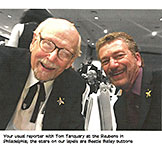
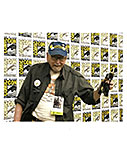

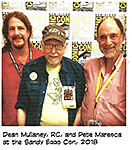
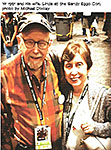
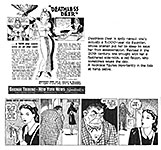
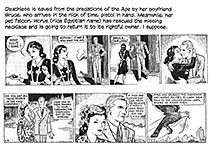
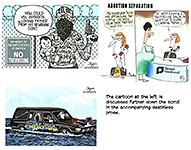
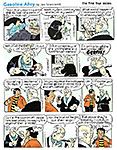
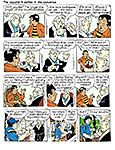
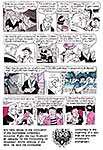
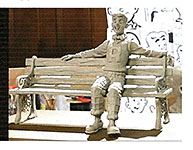
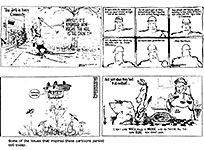
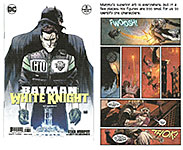
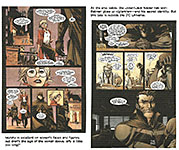
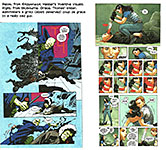
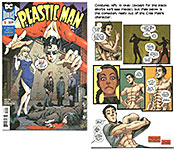
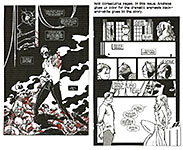
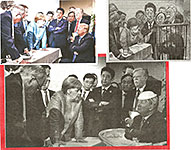
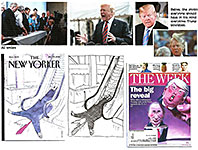
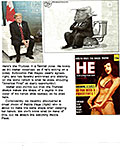
1.jpg)
2.jpg)
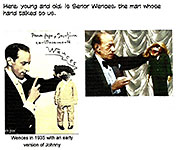

3.jpg)
4.jpg)
5.jpg)
6.jpg)
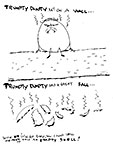
1.jpg)
2.jpg)
3.jpg)
4.jpg)
5.jpg)
6.jpg)
